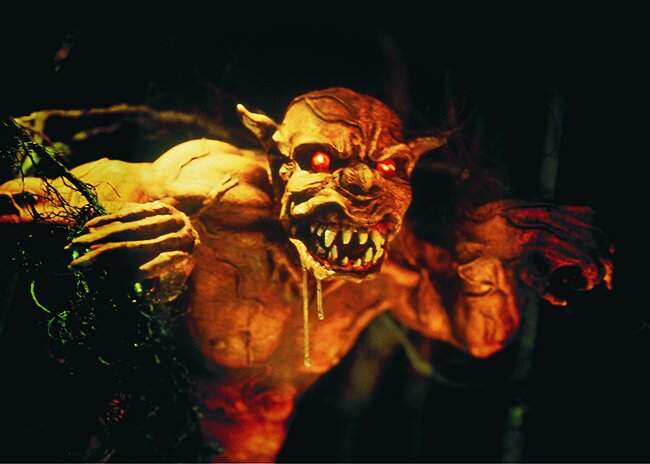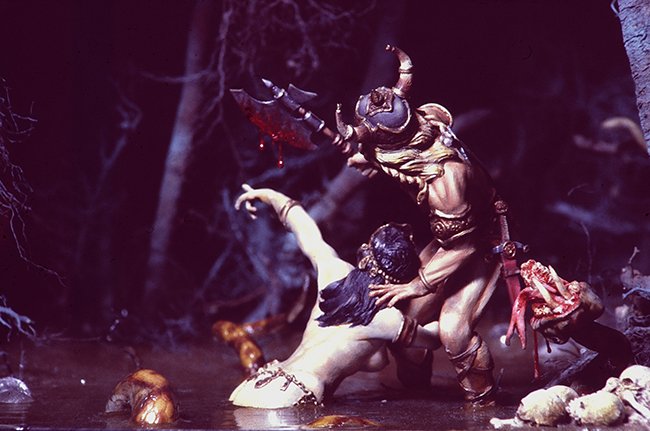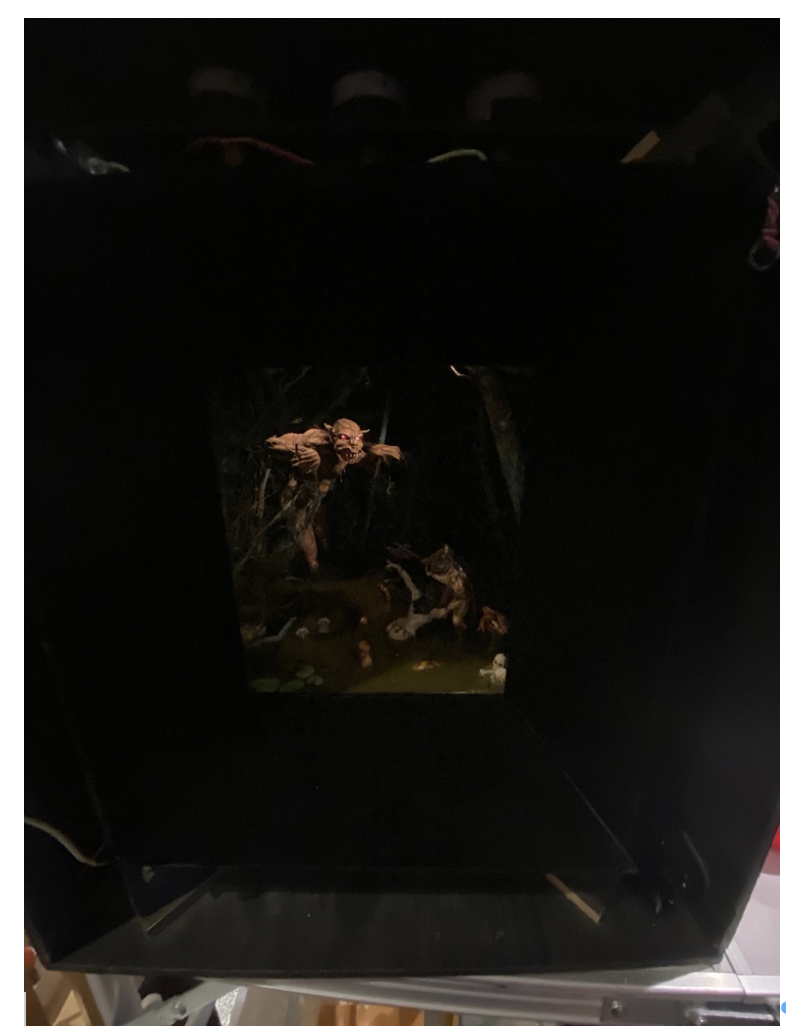This box is now in the collection of Darryl Audette
Shep’s comments on the box
I first became interested in doing a fantasy piece because I felt that the subject deserved better work that was getting at the time, and somebody ought to “do it up right.” Since then, some excellent fantasy work has been done in dioramas, but at the time of the Swamp Ogre there was nothing worthwhile.
I had always enjoyed the lush coloring and rich atmosphere of Frank Frazetta’s paintings and realized that this was what I really wanted to do — a three-dimensional Frazetta. I did not, however, ant to copy an existing painting. Rather, I was looking to capture the essence of the style, making people think it was based upon a painting, but to be unsure which one. I’m not sure how successful that was—I still have people coming up to me insisting they have seen the painting I based it on!
The design of the monster was fun and was based upon other monsters I’ve seen done, with a sprinkling of lizards and other reptiles from zoology books. The other features and creatures in the seen form a litany of Frazetta clichés — since this was likely be my only foray into Frazetta, I figured I might as well pull out all the stops! The various snakes, lizards and other creepy-crawlies lurking in the corners and background, the skulls and bones, the bubbling swamp gas — all are stock characters in this type of work. The hero and heroine in their clothing (or lack of it) are again standard Frazetta treatments: nothing specific but stylistically the same.
The Swamp Ogre is, of course, very much a mood piece and while all the characters and accessories do their part, the diorama really needs the lighting to carry it off. The scene had to be dark, but not too dark. with stronger dramatic light on the heroic couple and the ogre. The difficulty was that the source of this light had to be hidden, and much experimentation was done with masked spotlights until the desired effect was obtained. An additional surreal effect was created by placing a light under the water, giving the whole scene is sort of supernatural glow.
This was, in a word, a “fun” piece, slightly tongue-in-cheek. and I was surprised and delighted with the enthusiastic response it engendered.
From Sheperd Paine: The Life and Work of a Master Military Modeler and Historian by Jim DeRogatis (Schiffer Books, 2008)
J.D. You took a sharp turn with your next box, diving into fantasy with “The Swamp Ogre.”
S.P. This was done when the Frank Frazetta books first came out. A lot of fantasy figures were turning up at the shows at the time, but they generally weren’t very good. I thought, “Somebody ought to do better than this.”
I wasn’t really into fantasy at all, so I decided to take all of the Frank Frazetta clichés and put them into one scene. In later years, people would tell me that it was based on their favorite Frazetta painting, but it wasn’t—it was my own idea based upon what I’d seen him do.
It was a fun project from beginning to end. I’d never really sculpted any fantasy stuff before, so I put in all the classic fantasy characters: the hero in the horned helmet with the funny-looking ax; the voluptuous naked lady; the monster; the snake, and the skulls—everything I could think of, plus an Easter egg with the lizard off to one side.
J.D. Then you had some fun with the lighting.
S.P. Oh, I did. I was experimenting with a variety of different things. Aside from the spotlights that illuminated the monster and the couple, there was also a light underneath, coming up through the water. The water is a sheet of clear plastic with some resin on top of it to provide the water-like texture. The bubbles came in a moment of inspiration. If you’re going to have a swamp, you have to have swamp gas, so I experimented with a number of different ideas, like trying to blow bubbles into the resin as it was hardening. Then, it suddenly struck me that there was an easy way to do this: I called my friends at Monogram and asked them to send over a selection of clear plastic aircraft navigation domes in different sizes, and those became the bubbles. They worked perfectly: I just dropped them into the resin as it was drying.
J.D. Did you cut the figures in half at the water line?
S.P. They weren’t cut in half—they were cut to the level of the water. They don’t extend below, because it was murky water and you couldn’t see. When I say there was light in the water, there’s enough there to give it an eerie glow, but not enough to actually cast shadows. The monster also has grain-of-wheat bulbs for his eyes.
J.D. And he’s drooling all over the place...
S.P. The drool actually is a clear bristle from a plastic hairbrush. I dribbled some five-minute epoxy on it to create the ball at the end.
J.D. That’s pretty ingenious!
S.P. Well, the monster had to drool, and I was just looking around and saying, “What do I have that can make him drool?” One of the most rewarding aspects of this hobby is found-object art: I’m always hunting around, looking at things, and thinking, “Now, what can I do with that?” Most of the trees in this scene are just branches I found on the ground; I don’t think I actually sculpted the tree trunks.
J.D. Given that this was a departure for you, what was the reaction like?
S.P. I don’t think people expected it, but I think they’d gotten to the point where they didn’t know what to expect from me. Somebody joked that I ought to title this one, “No, dear, I thought you paid the electric bill!”
RESTORING THE BOX IN 2023
Above: Before restoration. Surprisingly, some of the lights were working (they hadn’t been in Beloit), but only dimly, and the rheostats (below, in a view of the roof of the inner scene) had badly oxidized. The light under the swamp was burned out, and one of the ogre’s eyes stopped working after a short time. The top had two of Shep’s brass-tube spots extending into the box, and I replaced the bulbs in those with LEDs.
Above: The inner tray removed from the box. Below: New lights installed. I placed new dimmers everywhere Shep had one—one on the spots on the figures, one on each of the spots above, one on the lights below the swamp, and one on the ogre’s eyes—so there is A LOT of control.









